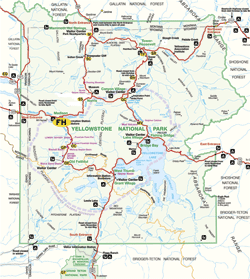
Firehole Canyon
Firehole Canyon has been carved by the river through a rhyolite lava flow, revealing its internal structure. Rhyolitic lava is extremely viscous and does not flow readily. As it moves, the interior of the lava remains mostly intact as the outer layers deform from the shear at the margin. Sections of the rock in the roadcut show the pencil-thin layering that was produced. The dark grey portions have a glass texture from rapid cooling; the lighter layers are crystals of quartz and feldspar. At one spot in the roadcut you can see boulders within the flow resulting from hotter lava encapsulating cooler pieces of lava that had already solidified.
The falls and rapids in the river result from the differential resistance of the rocks to the river's erosion. The edge of the Nez Perce Creek flow (150, 000 years old) creates the falls; the scarp across the river is formed by the West Yellostone flow (111, 000 years old). The contact between these two flows controls the course of the river.


